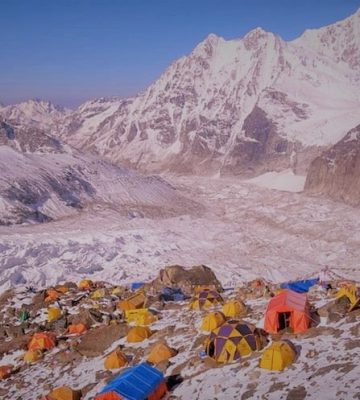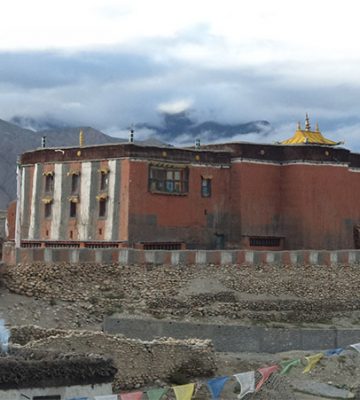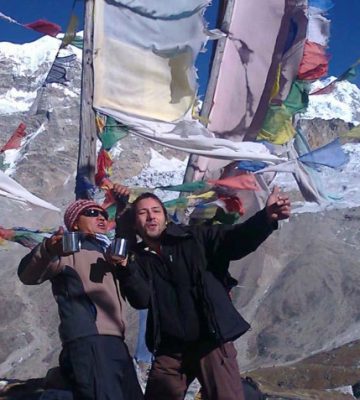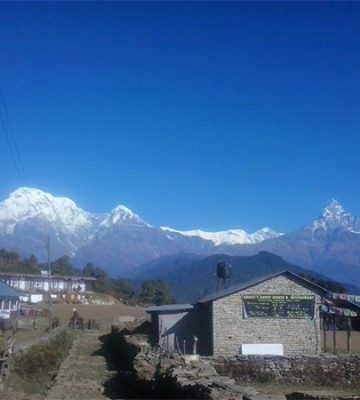Trekking in Nepal is the most gifted activity to spend your vacation. Being in the core of the Himalayan range, it provides routes and trails unlike anywhere on the planet.
From rough and off-the-beaten to well-managed luxury, it has something for every trekker out there. If you are a traveler seeking a lifelong adventure, you wouldn’t want to miss trekking in Nepal. It is a balance of physical and mental activities each more delightful than others.
Trekking is a great way of spending a vacation in Asia. It is a healthy initiative, a treat of cultural and natural delights. For solo, couple, and family vacations, you can choose different lengths and levels of trekking routes.
The best company for Trekking In Nepal
Magic Himalaya Treks is a locally owned Nepalese Trekking Company. It is based in the capital city Kathmandu of a small Hindu nation in Nepal. The company is well known for Major delightful and memorial holidays.
Our company highlights leisure tours to challenging adventure trips to the various Himalayas in Nepal along with Bhutan, Tibet, and some parts of India.
Magic Himalaya Treks is specialized in organizing private as well as group joining adventures. Here, adventures are Trekking, Hiking, peak climbing, mountaineering, Jungle safari, etc.
We are one of the few adventure trekking companies offering the best quality services to our valued guests and travelers. After the trip end people rated us high with the Best company for trekking in Nepal.
Best Time to Trek
Trekking at different times of the year can treat travelers with a diverse set of experiences in the Himalayas. The same trail might gift you with many unique escapades surprising you throughout any trek. It’s best to know what time to visit the Himalayas for achieving your goals while trekking here.
Nepal witnesses major four seasons. For everyone, autumn (September-November) and spring (March to May) is the most favorable and rewarding time to trek in the Himalayas. We will here break down the experiences and best regions you can go for trekking during it these four seasons.
a. Spring
Spring extends from March to May in Nepal. It is one of the most beautiful times to be in Nepal. Spring is also the second most preferred trekking season in the country. The mountain views are pristine. This is the time the Rhododendron blooms lighting the hills and trails of Nepal.
Best Regions to Trek
Everest Region
- Everest Base Camp Trek
- Gokyo Valley Trek
- Everest base camp Luxury Trek
- Renjo la pass trek
- Everest base camp yoga trek
- Gokyo Everest base camp trek
- Everest High Pass trek
Annapurna Region
- Annapurna base camp trek
- Jomsom Muktinath trek
- Annapurna circuit trek
- Mardi Himal Trek
- Ghorepani Poon Hill Trek
Upper Dolpo
- Lower Dolpa trek
- Upper Dolpa Trek
b. Autumn
Autumn is the best season to visit Nepal from November to September. The beauty of the Annapurna is best exposed throughout the trail. All small and big tea houses are operational and you can have a comfortable trekking session here.
Following the monsoon, the trail is pretty and hardly dusty in the mountain winds. The trees are green and the landscape looks completely transformed when you come here.
Additionally, some festivals also fall in the Autumn Season here and by overlapping your trekking period with them Bonus cultural delights are almost promised.
Best regions to trek
- Every area with the Dhaulagiri and Kanchenjunga treks best possible during autumn
- Off the beaten trails (Khopra Danda, Simikot-Limi Valley, Ruby Valley, etc)
c. Winter
Trekking Nepal in the winter season can be seen as OK if you are not doing high passes. Most Himalayan high passes are not safe to do in winter due to heavy snowfall and slippery trails.
However, if you are looking for an adventure then winter is open for you. The trail is empty for the most part and you might be among a few trekking then. You should also remember that not all tea houses and lodges are open during winter so you might have to contact beforehand and know the available ones here.
You can choose the less snowy trails to trek during winter with precaution.
Best regions to trek
1. Mardi Himal
2. Ghorepani-Poonhill
4. Other cultural treks in the lower Himalayas
d. Monsoon
Most trails can be difficult to cover during heavy monsoons. This is also the summertime and might provide the best views of the hills. You can expect a great view when the weather is clear but that is far less to be noticed.
However, the places under the rain shadow of high mountains (Manang, Mustang, Tsum Valley, and Dolpo) are the safest and most rewarding regions to trek in the monsoon season.
Best regions to trek
1. Upper and lower mustang Region
2. Tilicho Lake/Naar Phu Valley Trek
3. Dolpo and Phoksundo trek
4. Tsum Valley (Manaslu region)
Experience and Fitness required for trekking in Nepal
Some trekking routes are harder than others. That’s the universal truth. The best thing about Nepal is there is always one for you. Experience and Fitness might be less of a concern given that you have a licensed guide accompanying you.
Staying fit, however, certainly helps for your good. You should know how long and strenuous your trek is going to be beforehand. With Magic Himalaya, you can have an ideally managed trekking segment completed with ease.
Experience is important so that you can strategic your walking techniques before the trek. Connect with us and we will give some useful insight on how to conserve your energy and grow stamina throughout your journey. Our professional dietician will also assist you for weeks before beginning the walk for better results.
One of our recommendations is to separate a couple of days and do short day hikes around the valley with us. It will help a lot, a warm-up segment for the actual trek in higher elevation. So, with proper guidance, you mustn’t necessarily be an experienced trekker here in Nepal.
Another very important part is planning. It will not be pleasant, even for the fit and experienced if you don’t plan for the trek. Yes, taking a trek with a travel operator will help.
But if you are looking to head towards the remote regions solo, be sure to spend a sweet time planning each day, stop, route, trail, and much other stuff. With Magic Himalaya, we will assist you in giving you the highest level of ease in completing any trek.
Trekking Grades in Nepal
We can broadly divide the trekking grades of Nepal into five classes depending upon their difficulty and trail. Remember each person can do it and have their own experience. For an average traveler here are the classification and examples.
-
Easy (Grade A)
– These are easy and regular treks best for a family vacation
– Any fitness level and no prior experience is acceptable
– Well-facilitated trail with facilities
– 5 hours or less walk per day
Examples
- Ghorepani Poonhill Trek
- Mardi Himal Trek
- Lower Mustang trek
-
Moderate (Grade B)
– Basic fitness required with good stamina required
– Might last from a week to 10 days
– Around 5-6 hours of daily walking
– Elevation not exceeding 5000 meters
Examples
- Langtang Valley trek
- Pikey peak trek
- Gosainkunda Helambu Trek
-
Hard (Grade C)
– Prior trekking experience is required or a well-informed and licensed team
– Trekking duration might exceed 2 weeks
– Uneven trekking days with difficult segments
– The trek might exceed 5000 meters in elevation
Examples
- Annapurna Base Camp trek
- Upper Mustang Trek
- Lower Dolpa trek
-
Very Hard (Grade D)
Top fitness is a must with very good health
- Prior trekking experience is required or a well-informed and licensed team
- Trekking duration might exceed 2 weeks or more
- Uneven trekking days with more difficult segments
- Trek will exceed 5000 meters in elevation with high passes
Example
- Everest Base Camp Gokyo trek
- Annapurna Circuit
- Manaslu Circuit trek
5. Strenuous (Grade E)
- Top fitness is a must with very good health
- Prior to trekking, climbing, and camping experience is required, or a well-informed and licensed team
- The trail has difficult and challenging sections and might take long walking segments.
- Uneven trekking days with difficult segments
- Trek will exceed Alpine region for most days with the possibility of altitude sickness
- The rural part of the Himalayas with fewer facilities
- Good acclimatization breaks might be required throughout the trek
Example
- Everest Three Pass trek
- Dhaulagiri Base Camp/circuit trek
- Kanchenjunga Round Trek
- Upper Dolpa trek
Equipment and Supplies for Trekking in Nepal
Being well prepared is a wise thing to do while you are trekking Nepal in the Himalayas. However, in some cases packing heavy might just be unnecessary. Always consult with an expert and assemble the supplies and gear for your trek. Here is a suggested equipment checklist from our professional team for that purpose.
Sleeping
- Tent (necessary for the treks with camping
- Sleeping bag (–15° bag will be enough on most treks)
- Silk liner
- Sleeping pad
Hiking
- Backpack of optimal size
- Hiking boots (Use them prior as it’s more comfortable than a new one)
- Camp shoes for overnight use
- Wool socks- a few pairs of varying thickness
- Lightweight trekking pants
- T-Shirts – a few pairs
- Trekking shorts
- Underwear- clean and a few pairs
For trekking in higher elevation
- Fleece
- Long underwear as well as Wool thermals
- Sweater
- Waterproof set of jacket and pants
- Heavyweight pants (also good for camping in higher elevations)
- Winter woolen cap
- Heavy down jacket
- Woolen gloves (windproof)
Additional gear and supplies
- Water bottles
- Water purification tablets
- Caps against sunlight
- Hiking poles
- Sunglasses
- Headlamp (a pair of extra batteries)
- Reading materials (For rest days – Kindle paper suggested)
- Camera equipment as well as an extra battery and memory cards
- Small day pack with easy-to-access equipment (raincoat and other stuff)
- Gaiters (most recommended for rainy days)
Personal Supplies
- Sun Screen
- Toiletries (toothbrush, deodorant, toothpaste, hand sanitizers, towels, etc.)
- Face / Body wipes (Game changer in higher elevations where showering isn’t always the best option)
- Hydration pack for easy and regular hydration
- Medication and first aid kit
- lip balms
To know more about the packing list visit our site.
Group and Solo Trekking
Both trekking in a group, as well as solo trekking, has their own experiences. While some people like to share the trail with others, some like to do it alone. There are many reasons behind it and you can choose and differ between these two to select your ideal one.
Group Trekking
In a group trekking, you will join a group of a certain size for trekking in the Himalayas. these groups are with a maximum limit and most definitely the trek takes place at a fixed departure date. You will share the transport and accommodation with this group.
Depending upon the size of the group, there will be one or more guides for the trekking session. Group trekking is one of the most preferred trekking types in Nepal.
Advantages
- A cultural treat to share with fellow travelers from all over the world
- It is safer to travel with a group in some of the rural areas of Nepal
- Group trekking is a budget-friendly way of trekking in Nepal although you can join a luxury trekking group of your choice.
Downside
- You have to move with the group so the group preference has precedence over personal ones.
- Not the best trek for introverts
- You will not have a personal guide
Solo Trekking
Solo Trekking is a personalized trekking type where you can enjoy the freedom of walking alone with your guide in the Himalayas. These treks are highly customizable and fit your time of vacation. Solo trekking is ideal for adventure lovers wanting to do the trek in their own way. You can choose the best transport and accommodation fitting your wants with solo trekking.
Advantages
- You can spend the trek as you wish as long as it doesn’t change the itinerary.
- You’ll have your own guide and porter, hence the best assistance guaranteed.
- The rest session can be set for your comfort level without hampering other trekkers.
Downside
- It might be a bit more costly than group trekking
Independent and Guided Trek
While in some of the restricted regions in the Himalayas, taking a licensed guide with you is mandatory, it’s not the same in other trails. For most treks, you can choose either to do guided or independent ones. Statistics show that over 95 percent of all trekkers choose to take a local guide while trekking in the High Himalayas.
Guided Trek
The guided trek is the most common way of trekking in the high mountains. It is certainly the safest way to complete any trek in Nepal. Trekking in the rural Himalayas of Nepal is no child’s play. The trails can get tricky and you can just miss local personnel to guide you through it. Adding to it, a guide is an expert on trekking with knowledge of the local language, terrain, and everything in the trek.
He/She will help you strategize each day of the trek, getting the best meals and accommodation facilities. Your guide will have trained for a crisis and have a sound knowledge of first aid both being a saver in the mountains.
You’ll simply make the most of your trekking journey with a well-informed licensed guide. We at Magic Himalaya have a team of experienced guides specializing in their routes after a number of treks in the Himalayas. With our guided trek you can just relax as well as enjoy the delights of the Himalayas in its best shades.
Independent Trek
Independent trek is a bit risky if you have no prior experience in trekking and navigating in the high Himalayas. Here are our few tips for Independent Trekkers: –
- Research if you can do the trek independently or if the route has a compulsion of guide
- Pack optimally with everything required for the trek
- Take a detailed map of the region, if possible you can look at the vlogs or journals before commencing the trek.
- Do a warm-up trek to know your limits.
- Don’t go making your own itinerary, the standard ones are the best to follow.
- Prepare for Altitude sickness, losing the trail, or other unfavorable conditions while walking on the trail
- Research the hotels/lodges/tea houses for the trek as well as try booking it before the trek.
- Always carry your documents, permits as well as important stuff.
Tea house trekking in Nepal
Tea house trekking is the best way to trek in the mountains if you want to have a taste of local culture and lifestyle. Like the name suggests it is simply doing the same trail but staying selectively in the Tea houses. Tea houses are locally operated hotels providing you with beds and food. It is sometimes operated by a community aiming for the growth of the local economy.
Tea house trekking is an all-out local experience and it shows the true side of people living in those areas. Each destination embraces you with love and hospitality, unlike any other place in the country.
Treating you with organic products and delicacies, Tea House Trek shows you the best of the Himalayas. For trekkers, it’s a way of aiding the local economy and learning the way of life in the hills and mountains of Nepal.
Camping Trek in Nepal
Camping treks are some of the most adventurous trekking variations to complete in the Himalayas. You will have the freedom to set up your camp in the best locations on any trail.
Camping trek is the best way for anyone to connect with the geography and nature of any place. It is also ideal for doing excursions to off-the-beater trails in the rural Himalayas. Stopping without worries to reach the next settlement and less pressure to complete the day’s trek are other advantages.
Camping requires experience technique, and fitness if you are doing it alone. Or you can simply head out for any trek in the Himalayas with the Magic Himalayas team for a camping trek. Our set of individuals constitutes a guide, porters, and cook for your journey.
Altitude Sickness
Altitude sickness is a negative health effect that is experienced due to rapid exposure to lower/thinner levels of Oxygen at high elevations. It is common for most trekkers to head over 4000 meters in elevation. As stated earlier it’s common with trekkers but only fatal to a few with continued ascend.
Acclimatizing is the best way to cope with the body with higher elevation and travelers can spend some days solely for this purpose of preventing Altitude sickness. The main symptoms of mild/acute mountain sickness (AMS) are as follows: –
- Headache
- Nausea
- Shortness of breath
- Vomiting
- Tiredness and Sleeplessness
If some or other symptoms of AMS occur take some tips or medication for it from your guide.
In the case of its most serious forms High Altitude Pulmonary Edema (HAPE) and High Altitude Cerebral Edema (HACE) immediate descent or rescue should be done in time.
Here are some of the preventive measures which you can follow for Altitude Sickness: –
- Advance slowly as well as steadily in higher elevation
- Rest at the regular interval while trekking
- Rehydrate in a regular interval (a liter for every couple of hours or so)
- Avoid alcohol as well as eat a balanced diet
- Get plenty of rest and sleep
- Carry some medication with you
- Short hikes as well as warm-up exercises every day for better acclimatization
- In case of difficulty, the best option is to drop down to a lower elevation as well as consult the doctor for a check-up.
Regarding Trekking in Nepal if you have any questions then you can check on Trekking in Nepal FAQs on our blog.
If you don’t get your answer there then contact us by email. We will give you the answers quickly, You can also chat with us.






